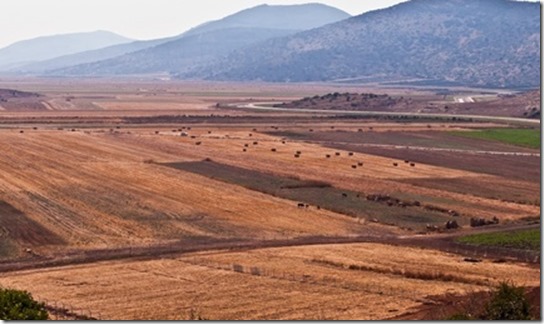 We have just published an article about preparing for the Sabbatical year. In this article, we stated as it is written in Scripture, that the Sabbatical year is for the land. Have you ever wondered why that is? Why did YHVH give us an instruction to let the land rest? A good friend of ours, Joseph Dumond, recently published an excellent article answering this question.
We have just published an article about preparing for the Sabbatical year. In this article, we stated as it is written in Scripture, that the Sabbatical year is for the land. Have you ever wondered why that is? Why did YHVH give us an instruction to let the land rest? A good friend of ours, Joseph Dumond, recently published an excellent article answering this question.
We have also put some of these principles in place, in view of the coming Sabbatical year, and although it has only been a couple of months, we are seeing results. It is exciting to see how YHVH’s principles work in practice. May this inspire you!
Just to give you some background, we find the commandment to let the land lie fallow in Ex 23:11.
Exodus 23:11
11 but on the seventh year you shall let it rest and lie fallow, so that the needy of your people may eat; and whatever they leave the beast of the field may eat. You are to do the same with your vineyard and your olive grove.
Here is his article.
In years gone by, farmers used to let the land go fallow every so often to benefit the land. As a boy, I can still remember the farmer next door fallowing a field. What he was doing was not planting that field, and letting the cattle and horses eat and walk in it. To me, fallowing a field meant that the animals would fertilize the field. From this we get the expression to dung a tree. It was the manure that stimulated the tree and caused it to grow faster or healthier. For me, this same thing helped the fields that were being fallowed.
Luke 13:6-9
6 And He began telling this parable: A man had a fig tree which had been planted in his vineyard; and he came looking for fruit on it and did not find any. 7 And he said to the vineyard-keeper, Behold, for three years I have come looking for fruit on this fig tree without finding any. Cut it down! Why does it even use up the ground? 8 And he answered and said to him, Let it alone, sir, for this year too, until I dig around it and put in fertilizer; 9 and if it bears fruit next year, fine; but if not, cut it down.
The kIng James Version has “dung it” instead of “put in fertilizer”.
But where did they get this idea to let the land go fallow? Why did they do it? First, let’s look up what it means.
What does the word fallow mean?
ADJECTIVE (Of farmland) plowed and harrowed but left unsown for a period in order to restore its fertility as part of a crop rotation or to avoid surplus production:incentives for farmers to let the land lie fallow in order to reduce grain surpluses
Old English fealgian to break up land for sowing, of Germanic origin; related to Low German falgen.
Origin
Old English falu, fealu, of Germanic origin; related to Dutch vaal and German fahl, falb.
From the JPS version we read the following:
Exo 23:10 And six years thou shalt sow thy land, and gather in the increase thereof; 11 but the seventh year thou shalt let it rest and lie fallow, that the poor of thy people may eat; and what they leave the beast of the field shall eat. In like manner thou shalt deal with thy vineyard, and with thy olive yard. 12 Six days thou shalt do thy work, but on the seventh day thou shalt rest; that thine ox and thine ass may have rest, and the son of thy handmaid, and the stranger, may be refreshed. JPS version
And from the King James we have:
Exo 23:10 And you shall sow your land six years, and shall gather in the fruits of it. 11 But the seventh year you shall let it rest and let it alone, so that the poor of your people may eat. And what they leave, the animals of the field shall eat. In the same way you shall deal with your vineyard and with your olive yard. 12 You shall do your work six days, and on the seventh day you shall rest, so that your ox and your ass may rest, and the son of your handmaid, and the stranger, may be refreshed. NKJV
The word let it alone in verse 11 is:
H8058 shâmaṭ shaw-mat
A primitive root; to fling down; incipiently to jostle; figuratively to let alone, desist, remit: – discontinue, overthrow, release, let rest, shake, stumble, throw down.
This word Shamat is the word from which we get the word Shemitah from: to let the fields alone.
When we fallow our fields, we are letting the land rest, letting the land alone. This idea comes from Lev 25.
Lev 25:3 Six years thou shalt sow thy field, and six years thou shalt prune thy vineyard, and gather in the fruit thereof; 4 But in the seventh year shall be a sabbath of rest unto the land, a sabbath for the LORD: thou shalt neither sow thy field, nor prune thy vineyard.
I want you to notice something here.
a sabbath H7676 of rest H7677
We are to have a Sabbath
H7676 ש×בּת shabbaÌ‚th shab-bawth
Intensive from H7673; intermission, that is, (specifically) the Sabbath: – (+ every) sabbath.
We are to have a Sabbath of rest.
H7677 shabbâthôn shab-baw-thoneFrom H7676; a sabbatism or special holiday: – rest, sabbath.
In my limited research, I have only found those of the descendants of the tribes of Israel actually letting the land go fallow, wherever we are able to trace them. But those nations not from the tribes of Israel never practiced this. At least, as far as I have been able to determine.
Let me now share with you what people today think fallowing your fields means.
What is Fallow Ground?
By Timothy Baron, eHow Contributor
Agriculture can be draining to the soil, especially when farmers plant the same crop year after year. The reason is simple: Each species of plant leeches something from the soil while giving something else back. For instance, soybeans leave nitrates in the soil while corn absorbs nitrates. To replenish the chemical composition of soil after a crop, some farmers let their land go fallow so that the native plants can naturally restore the soil’s balance.
Crop Rotation
The core philosophy behind crop rotation is that letting a field lie fallow enables it to restore minerals depleted by crops. Crop rotation is all the more important in fields where the soil is prone to depletion or where demanding crops have been grown.
Medieval Agriculture
Allowing land to stand fallow was commonly done in Medieval times when technologies had yet to develop that permitted persistent planting in a field. Since the advent of commercial fertilizers and the increasing understanding of common planting, it has become more and more unpopular to leave land fallow in Western societies. Leaving the land fallow reduces yields considerably.
Two-Field Rotation
The most primitive form of crop rotation was known as two-field rotation. Farmers would divide their fields in half, planting on one half in one year and then the other half the following year. This cycle would then repeat itself indefinitely. Although this process had the intended effect of replenishing the soil, it left half of the arable land unused.
Three-Field Rotation
Three-field rotation was a more advanced form of crop rotation. As the name suggests, arable fields were divided into threes. In the first field, a farmer sowed grain such as barley or wheat. In the second field, he planted a legume such as lentils or peas. The legume helped replenish nitrogen depleted by the grain. The farmer left the third field fallow so that other nutrients could return to the soil. Although this technique was considerably more efficient than two-field rotation, one-third of the arable land went unused.
Modern Practice
In modern practice, fallowing is generally considered a last resort, with fertilizers and intelligent companion planting coming first. When it is used, it’s often seasonal as opposed to annual. Instead of leaving a field fallow for an entire year, a farmer might engage in summer fallowing, harvesting one crop in the late spring and planting the following in early fall.
Brethren, did you catch what was just said above? Fallowing of the fields, giving the land a Sabbatical year, is generally considered a last resort! Each of the methods mentioned above were used in an effort to maximize the production of the land (better known as greed), and to do that they had to circumvent the law of letting the land rest for an entire year as they were told at Mount Sinai about the Sabbatical years.
So, to get around this they did two or three field rotations of crops or just summer fallow the land. This along with a healthy doze of fertilizers and crop rotation and companion planting they have revolutionized the farming industry.
An environmental tragedy is occurring across North America virtually unnoticed. A fallacy, an idea seemingly fostered and encouraged by large chemical companies, is that lands used for the production of agricultural crops never have to be fallowed. North American agribusiness conglomerates insist that by using their products, artificial fertilizers, pesticides and herbicides, agricultural lands can be planted and cropped annually, maximizing farm income, without any interruption in cropping each year. Nothing could be further from the truth. And people wonder why all the bees are dying off.
Unfortunately, many farmers originally bought into this dream and applied chemicals heavily to their soils for years and wondered why the soil was deteriorating. Much wonderful and productive agricultural land has already been destroyed. When soils begin to deteriorate, use of chemicals demands that increasingly more artificial fertilizer be used every year to maintain the same production and in extended practice, accelerates the destruction of the soil.
Thinking farmers, the wise stewards of the land, are increasingly and admirably learning of the harm done by perpetual, heavy chemical usage and have started using environmentally smarter farming methods that involve using less chemical and more natural methods which are less destructive. Similar to any drug addict with a dependency, the land must be weaned off of chemicals.
Anecdotal evidence of the harm done by chemical agriculture abounds across North America. Excessive and continual chemical use results in highly compacted, barren mineral soil no better than poor quality, silty mud containing few nutrients and has no friable tilth, or soil structure.
Such soil contains little or no organic material, tends to compact as hard as cement, and has few natural microbes or beneficial soil inhabitants such as earthworms or beetles. With no organic material remaining, the barren, chemically-overloaded soil has little capacity for holding natural moisture from rainfall. The soil is in rapid decline and dies. Thus we have flooding with each rain fall across the land and around the world.
Why? The industrial chemicals and fertilizers overload and systemically poison the soil, killing the natural flora and fauna. The soil subsequently loses all organic matter and packs to a layer of hardpan. The soil does not hold water, so artificial nitrates run off with rainwater into the nearest waterway, polluting tiny streams, great rivers, and lakes.
In areas of high concentrations of fertilizers, algal blooms abound in waterways, and underground aquifers are becoming completely polluted and unfit for human consumption.
Chemical farming is clearly destroying agricultural lands and simultaneously wreaking havoc on the environment. The reality is that most farmers struggling financially under staggering debt loads, must borrow money to buy ever more fertilizer and chemicals. They may be aware of the environmental and developing problem with the soil, but increasingly, must continue to pour more chemicals on their crops to survive financially.
For much of the farmland and for many farmers, it is too late. Much agricultural land has been destroyed and would take many years of very careful management and financial support to recover to it’s original state of health. Some agricultural lands are so badly depleted they are close to being permanently destroyed, if not already beyond repair.
The simple, healthy practice of allowing farmland to lay fallow has been ignored or stopped entirely in some areas because of economic pressure placed on farmers. Many farmers must use all of their available land for production or fail financially. A vicious cycle has been started and is perpetuated.
More expensive fertilizer is subsequently poured upon land that is already dying from being over cropped as a matter of financial survival.
What is the solution? To maintain productive, high quality soils, farmland must be allowed to lay fallow every few years. (Actually Yehovah said to do it once every 7 years)
What is the process of fallowing land?
The fallowing of soil is a rest or pause in a natural cycle of crop rotation. The sequence may vary, but a cycle is started. A grain crop might be followed with a green manure crop which is plowed under for fertilizer. The soil may or may not be allowed to rest for a year. A grain planting may follow, seeded simultaneously with seed for forage or hay crops, such as clover, timothy, or alfalfa. The grain acts as a shading cover crop for the developing hay crop.
The following year or two, hay or forage may be harvested. In a mixed farming operation, a natural rotation would be to include the pasturing of animals. Animals such as beef or dairy cattle on pasture, naturally fertilize and enrich the soil but mixed farming in many areas is almost a thing of the past. The following year, the land is ploughed and seeded to grain again.
On the final year of a six or seven-year cycle, the land is green manured by planting clover, buckwheat or legumes such as beans and the crop is ploughed under while green, but on this part of the cycle, the soil is then allowed to fallow, or rest, unseeded and unused, for a year or more. The cycle is started again.
Following a program of annual or semi-annual crop rotation, a growth of clover or other green plant material is ploughed under, and the soil is allowed to rest for a year or more. This process rebuilds the tilth of the soil, adds organic material, and revitalizes the natural microbial health of the soil. Clover and legume crops replace the nitrogen and phosphorous levels in the soil naturally, with no chemical fertilizers needed.
Earthworms consume organic matter, substantially enriching the soil with worm castings. Because the tilth of the soil is also improved with more organic matter and the increased activity of earthworms and other natural flora and fauna, the soil is better aerated . The health of the soil is substantially improved and with better moisture-retaining characteristics, less irrigation is required for successful crops.
Less artificial irrigation reduces the development of hardpan and leaching of nutrients from the soil, reducing the demand for more fertilizer. The improved water-holding characteristics of the soil reduce water run-off and pollution of nearby waterways, and also helps lessen the severity of annual floods in flood-prone areas.
What can replace the process of natural fallowing of lands and rotation of crops? There is no viable replacement for the fallowing of soil. Increasingly, farmers are investigating natural and organic farming methods simply because they know the environment needs to be protected, and that agricultural lands are a limited and precious resource.
What are the advantages of fallowing the land?
Fallowing of soils is clearly an essential agricultural practice that enriches the land naturally. Specific deep-rooted crops may help improve the land by leaving huge root systems underground when cropped, but will not solve the problem entirely. From a state of exhaustion, the soil needs time to build itself up. The fallowing of agricultural crop land is required.
To benefit the environment and return all agricultural lands to productive, long-term sustainability, agricultural policy that improve the financial viability for the farmers themselves is essential. Encouragement of all farming operations in North America to reintroduce fallowing cycles to their lands should be made a priority to preserve agriculture and life itself.
The above is from a series of articles. Let me just examine this a bit so you understand. When Yehovah says to let the land rest for one year in seven, ask yourselves why, so you can learn a valuable lesson. Yehovah, why do we have to let the land rest for one year out of seven?
When the farmer plows under a green crop what is he doing? He is giving food to the worms. The worms in turn produce castings. These castings then produce microbes and fungi, which is what gives life to the soil. When the cattle pasture a field what are they doing? They are also adding manure to the fields, which in turn is digested by worms and beetles and insects, which in turn produce these microbes and fungi the flora and fauna of the soil.
But each time the farmer plows the fields he is also killing the microbes and fungi, turning everything upside down.
Are you aware of what happened in the Garden of Eden?
Gen 2:15 And Jehovah God taketh the man, and causeth him to rest in the garden of Eden, to serve it, and to keep it. YLT
Gen 2:15 And the LORD God took the man, and put him into the garden of Eden to dress it and to keep it. JPS
Adam and Eve were to maintain the garden; to serve it and to dress it. I have done gardening and it is just a ton of work, but Yehovah says His yoke is light. So, have we been not listening all these years?
Mat 11:28 Come to Me all you who labor and are heavy laden, and I will give you rest. 29 Take My yoke on you and learn of Me, for I am meek and lowly in heart, and you shall find rest to your souls. 30 For My yoke is easy, and My burden is light.
Because of Adam and Eve’s sin the ground became cursed. The land, the earth became cursed because of Adam’s sin.
Gen 3:17 And to Adam He said, Because you have listened to the voice of your wife and have eaten of the tree, of which I commanded you, saying, You shall not eat of it! The ground is cursed for your sake. In pain shall you eat of it all the days of your life. 18 It shall also bring forth thorns and thistles to you, and you shall eat the herb of the field. 19 In the sweat of your face you shall eat bread until you return to the ground, for out of it you were taken. For dust you are, and to dust you shall return.
I also want to point out to you something I learned only a while ago. In the Garden of Eden, Adam and Eve dressed the Garden and rested in the garden. It was not until they were put out of the Garden that they actually began to till the land.
Gen 3:23 therefore Jehovah God sent him out from the garden of Eden to till the ground from which he had been taken.
Back to Eden
I learned this, and many more things about the land, in the Back to Eden video. Three years ago I stopped tilling the ground, cutting the worms in half and turning the bacteria growth upside down and killing it. Bacteria grows near the surface of the ground. Turning it over each year kills it off over time and by giving the land a rest every seventh year, the life of the soil is allowed to regenerate.
After three years now, I cannot dig anywhere in my garden without digging up hundreds and hundreds of worms. They are working on breaking down the food I give them. I now feed them rotting leaves and compost. I have a ten by ten by ten foot area of leaves I am composting along with the kitchen scraps I feed them. The worms make the castings that the plants thrive on.
To show you just how valuable these worm castings are and the bacteria plants need to grow in, take a few minutes to watch this video (I am working towards breaking some of his records). It is the bacteria created from the manure that causes the plants to thrive. We can grow large healthy plants by giving them large doses of this bacteria, also known as compost tea.
In the wild, Yehovah does not rotate the crops. He lets them grow in the same place year after year after year. He does not plow them under each year. What Yehovah does is feed the worms and the microbes a fresh new crop of leaves each year for them to chew on and digest and create castings which the plants thrive on. The soil never goes out of ph balance. Think about this. The soil holds more water and the plants are constantly moistened because the soil is covered in mulch which the worms eat. When the soil holds the moisture it prevents floods and then it sends up a mist. We see this today in the rain forests – moisture rising from the forest as the sun rises on it. This is the very same thing that Yehovah created in the Garden of Eden.
Gen 2:6 But there went up from the earth a mist and watered all the face of the ground.
Consider the curses of Lev 26 for not keeping the Sabbatical year.
Lev 26:18 And if you will not yet listen to Me for all this, then I will punish you seven times more for your sins. 19 And I will break the pride of your power, and I will make your heaven like iron and your earth like bronze. 20 And your strength shall be spent in vain. For your land shall not yield its increase, neither shall the trees of the field yield their fruits.
If we are doing as we should be doing and building up the soil each year and letting it rest on the Sabbatical years, then the floods would stop and the severe and extreme weather we now have would also stop. The soil would hold more water and send up a mist during the morning to water the plants and trees just as it did in the Garden of Eden. But now, because we do not and will not keep the Sabbatical year nor work on building up the soil, we have created the curse of Lev 26:18 ourselves.
I also want you all to consider the phenomenal growth of the plants in the Amazon jungles of South America. The plant life was thriving and naturally men thought they would just remove the brush and have all this fertile soil to grow their crops in.
It turns out that the soil only lasted a few years before the crops began to fail. So what do they do? They move to another part of the Rain Forest and burn it down, then they use the soil for a few years until it no longer can support them.
What is going on here? The worm life and microorganisms that feed the rain forest and make the earth alive were not being fed their steady diet of leaves and bark, to digest and produce the castings the plants needed. The soil in the rain forest was not very thick. All of this activity takes place at the surface. But once you kill the worms and the bacteria, by not feeding them, the soil dies. Yehovah is so brilliant to be able to create awesome forests on so thin a layer of soil, but what is in that soil and how it works is the secret to fallowing the land everywhere around the world. Not just for in the land of Israel.
Back to the question: Why do we have to let the land rest every seventh year? Why should we fallow our land as Lev 25 tells us to? The answer is obvious from the information provided above. If we are not going to grow our food without turning over the soil each year, then we have to let the worms and microorganisms have a chance to rebuild themselves up. But if we do grow our plants in the same area year after year and do not turn the soil over, then we should be growing healthier and larger produce.
In my yard I take all the grass clippings and leaves and if I do not feed the worm compost, I spread them in the fruit tree orchard I have. My fruit has had spots and insects, making the fruit very unattractive. By composting directly over the root system of the trees, I will be creating a good soil life for the trees to thrive on.
Sick plants are a result of sick soil. Healthy plants are not eaten by insects. Insects only eat the sick plants. Watch the two videos above and think about the things I have shared here as you go about planting your gardens this year.
Brethren, the purpose of this article was to explain about the microorganisms in your soil and how they make the soil alive.
Conclusion
So, what can we conclude from all this? What we have seen here is just one of the physical reasons for keeping the Sabbatical year. There are other reasons which we will go into next week. Let us summarize.
Firstly, the land belongs to YHVH, we are stewards and are therefore to care for the land as instructed by the owner of the land.
Leviticus 25:23
23 The land, moreover, shall not be sold permanently, for the land is Mine; for you are but aliens and sojourners with Me.
http://www.biblicalstudies.org.uk/pdf/eq/1984-3_wright.pdf
Secondly, YHVH, in His great wisdom has given us this commandment to keep the Sabbatical year in order to benefit us, wherever we are. If we do what we are commanded to do, we will reap the benefits. If we don’t we will suffer the consequences.
It may be challenging to keep the Sabbatical year in the nations, however, we are to do the very best we can. Here is some advice king David gave his son Solomon.
1 Chronicles 28:9
9 As for you, my son Solomon, know the Elohim of your father, and serve Him with a whole heart and a willing mind; for YHVH searches all hearts, and understands every intent of the thoughts. If you seek Him, He will let you find Him; but if you forsake Him, He will reject you forever.
We are to do the same, we are to know YHVH and serve him with a whole heart and a willing mind, for YHVH searches all hearts, and understands every intent of our thoughts. If we seek him, He will let us find him, but if we forsake him, he will reject us forever.
Once again, as we always say, we have a choice in this matter. We can choose life or death, the blessing or the curse.















Leave a Reply to Normajean Cancel reply